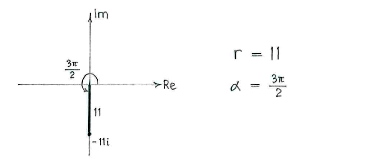Lösung 3.2:6b
Aus Online Mathematik Brückenkurs 2
(Unterschied zwischen Versionen)
(Ny sida: {{NAVCONTENT_START}} <center> Bild:3_2_6b.gif </center> {{NAVCONTENT_STOP}}) |
|||
| (Der Versionsvergleich bezieht 7 dazwischen liegende Versionen mit ein.) | |||
| Zeile 1: | Zeile 1: | ||
| - | {{ | + | Bestimmen wir den Betrag <math>r</math> und das Argument <math>\alpha </math>, können wir die Zahl auf Polarform durch die Formel |
| - | < | + | |
| - | {{ | + | {{Abgesetzte Formel||<math>r(\cos\alpha + i\sin\alpha)\,\textrm{.}</math>}} |
| + | |||
| + | schreiben. Nachdem die Zahl auf der imaginären Achse liegt, erhalten wir das Argument und den Betrag direkt. | ||
| + | |||
| + | [[Image:3_2_6_b.gif|center]] | ||
| + | |||
| + | Die Polarform ist daher | ||
| + | |||
| + | {{Abgesetzte Formel||<math>11\Bigl(\cos\frac{3\pi}{2} + i\sin\frac{3\pi}{2}\Bigr)\,\textrm{.}</math>}} | ||
Aktuelle Version
Bestimmen wir den Betrag \displaystyle r und das Argument \displaystyle \alpha , können wir die Zahl auf Polarform durch die Formel
| \displaystyle r(\cos\alpha + i\sin\alpha)\,\textrm{.} |
schreiben. Nachdem die Zahl auf der imaginären Achse liegt, erhalten wir das Argument und den Betrag direkt.
Die Polarform ist daher
| \displaystyle 11\Bigl(\cos\frac{3\pi}{2} + i\sin\frac{3\pi}{2}\Bigr)\,\textrm{.} |

